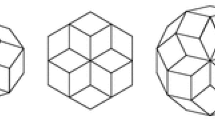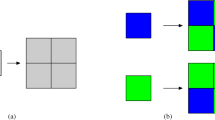Abstract
We present Planar Rosa, a family of rhombus tilings with a 2n-fold rotational symmetry that are generated by a primitive substitution and that are also discrete plane tilings, meaning that they are obtained as a projection of a higher dimensional discrete plane. The discrete plane condition is a relaxed version of the cut-and-project condition. We also prove that the Sub Rosa substitution tilings with 2n-fold rotational symmetry defined by Kari and Rissanen do not satisfy even the weaker discrete plane condition. We prove these results for all even \(n\geqslant 4\). This completes our previously published results for odd values of n.



















Similar content being viewed by others
References
Arnoux P, Furukado M, Harriss E, Ito S (2011) Algebraic numbers, free group automorphisms and substitutions on the plane. Trans Am Math Soc 363:4651–4699
Arnoux P, Ito S, Sano Y (2001) Higher dimensional extensions of substitutions and their dual maps. J Anal Math 83:183–2062001
Baake M, Grimm U (2013) Aperiodic order: a mathematical invitation. Cambridge University Press, Cambridge
Beenker FPM (1982) Algebraic theory of non-periodic tilings of the plane by two simple building blocks: a square and a rhombus. EUT report. WSK, Dept. of Mathematics and Computing Science
Bédaride N, Fernique Th (2015) When periodicities enforce aperiodicity. Commun Math Phys 335:1099–1120
Conway J, Jones A (1976) Trigonometric Diophantine equations (on vanishing sums of roots of unity). Acta Arith 30:229–240
Davis Philip J (1979) Circulant matrices. Wiley, New York
De Bruijn NG (1981) Algebraic theory of Penrose’s nonperiodic tilings of the plane. I and II. Kon. Nederl. Akad. Wetensch. Proc. Ser. A
Gahler F, Rhyner J (1986) Equivalence of the generalised grid and projection methods for the construction of quasiperiodic tilings. J Phys A Math General. https://doi.org/10.1088/0305-4470/19/2/020
Grünbaum B, Shephard GC (1987) Tilings and patterns. Courier Dover Publications, Mineola
Kari J, Lutfalla VH (2022) Substitution discrete plane tilings with \(2n\)-fold rotational symmetry for odd \(n\). Discrete Comput Geom
Kari J, Rissanen M (2016) Sub Rosa, a system of quasiperiodic rhombic substitution tilings with \(n\)-fold rotational symmetry. Discrete Comput Geometry
Kenyon R (1993) Tiling a polygon with parallelograms. Algorithmica 9:382–397
Levitov LS (1988) Local rules for quasicrystals. Commun Math Phys 119:627–666
Lutfalla VH (2021) An effective construction for cut-and-project rhombus tilings with global \(n\)-fold rotational symmetry. In: 27th IFIP WG 1.5 international workshop on cellular automata and discrete complex systems (AUTOMATA)
Lutfalla VH (2021) Substitution discrete planes. Theses, Université Sorbonne Paris Nord. hal:tel-03376430
Penrose R (1974) The role of aesthetics in pure and applied mathematical research. Bull Inst Math Appl 10:266–271
Senechal M (1996) Quasicrystals and geometry. CUP Archive, Cambridge
Socolar JES (1990) Weak matching rules for quasicrystals. Commun Math Phys 129:599–619
Solomyak B (1998) Nonperiodicity implies unique composition for self-similar translationally finite tilings. Discrete Comput Geom 20:265–279
Acknowledgements
We wish to thank Thomas Fernique for his help and proofreading.
Author information
Authors and Affiliations
Corresponding author
Additional information
Publisher's Note
Springer Nature remains neutral with regard to jurisdictional claims in published maps and institutional affiliations.
Technical details
Technical details
Lemma 34
(Decompposition of \(\mathbb {R}^n\) as the orthogonal direct sum of the spaces \(\mathcal {E}_n^k\)) For any even integer n. Define the planes \(\mathcal {E}_n^k\) for \(0\leqslant k < \tfrac{n}{2}\) as
The planes \(\mathcal {E}_n^k\) are pairwise orthogonal and their direct sum is \(\mathbb {R}^n\).
Proof
Remark that the fact that the direct sum of the spaces \(\mathcal {E}_n^k\) is \(\mathbb {R}^n\) is a consequence of the fact that they are pairwise orthogonal. Indeed if they are pairwise orthogonal then their sum is direct (trivial intersection) and the dimension of the sum is the sum of the dimensions so the dimension is n and the sum is \(\mathbb {R}^n\).
Now we prove that they are pairwise orthogonal. Take \(0\leqslant k_1< k_2 < \tfrac{n}{2}\). \(\mathcal {E}_n^{k_1}\) and \(\mathcal {E}_n^{k_2}\) are orthogonal, indeed :
-
\(\left\langle \left( \cos \frac{(2k_1+1)i\pi }{n}\right) _{0\leqslant i< n} \bigg | \left( \cos \frac{(2k_2+1)i\pi }{n}\right) _{0\leqslant i < n} \right\rangle = 0\), indeed we have
$$\begin{aligned}&\left\langle \left( \cos \frac{(2k_1+1)i\pi }{n}\right) _{0\leqslant i< n} \bigg | \left( \cos \frac{(2k_2+1)i\pi }{n}\right) _{0\leqslant i < n} \right\rangle \\&\qquad = \sum \limits _{i=0}^{n-1} \cos \frac{(2k_1+1)i\pi }{n}\cos \frac{(2k_2+1)i\pi }{n}\\&\qquad = \sum \limits _{i=0}^{n-1}\frac{1}{2}\left( \cos \frac{2i(k_1+k_2+1)\pi }{n}+ \cos \frac{2i(k_2-k_1)\pi }{n}\right) \\&\qquad = \left( \sum \limits _{i=0}^{n-1}\frac{1}{2} \cos \frac{2i(k_1+k_2+1)\pi }{n}\right) + \left( \sum \limits _{i=0}^{n-1}\frac{1}{2}\cos \frac{2i(k_2-k_1)\pi }{n}\right) \\&\qquad = 0 \end{aligned}$$Note that the important hypothesis is \(0\leqslant k_1< k_2 < \tfrac{n}{2}\) so \(0< (k_2 - k_1), (k_1+k_2+1) < n\) and \(\sum \limits _{i=0}^{n-1}\frac{1}{2} \cos \frac{2i(k_1+k_2+1)\pi }{n} = 0\) (and same with \((k_2-k_1\))).
-
similarly \(\left\langle \left( \sin \frac{(2k_1+1)i\pi }{n}\right) _{0\leqslant i< n} \bigg | \left( \sin \frac{(2k_2+1)i\pi }{n}\right) _{0\leqslant i < n} \right\rangle = 0\) with
$$\begin{aligned} 2\sin \frac{(2k_1+1)i\pi }{n}\sin \frac{(2k_2+1)i\pi }{n} = \cos \frac{2i(k_1+k_2+1)\pi }{n}- \cos \frac{2i(k_2-k_1)\pi }{n}. \end{aligned}$$ -
similarly we have \(\left\langle \left( \cos \frac{(2k_1+1)i\pi }{n}\right) _{0\leqslant i< n} \bigg | \left( \sin \frac{(2k_2+1)i\pi }{n}\right) _{0\leqslant i < n} \right\rangle = 0\) with
$$\begin{aligned} 2\cos \frac{(2k_1+1)i\pi }{n}\sin \frac{(2k_2+1)i\pi }{n} = \sin \frac{2i(k_1+k_2+1)\pi }{n}- \sin \frac{2i(k_2-k_1)\pi }{n}. \end{aligned}$$ -
similarly we have \(\left\langle \left( \sin \frac{(2k_1+1)i\pi }{n}\right) _{0\leqslant i< n} \bigg | \left( \cos \frac{(2k_2+1)i\pi }{n}\right) _{0\leqslant i < n} \right\rangle = 0\).
Lemma 35
(The billiard word \(w\) of slope \(\gamma\) is well-defined) Let n be an even integer at least 4. Let \(\gamma :=(\cos \tfrac{i\pi }{n})_{0\leqslant i < n/2}\). Let \(\Gamma _\frac{1}{2} := \langle \gamma \rangle + (\frac{1}{2} ,\frac{1}{2} , \dots ,\frac{1}{2} ) = \{ (\frac{1}{2} + t\cos \tfrac{i\pi }{n})_{0\leqslant i < n/2} |\ t \in \mathbb {R}^+\}\). Let \(H_{j,k}:= \{ x \in \mathbb {R}^{n/2}|\ x_j = k\}\) with \(j<\frac{n}{2}\) and \(k> 1\).
The billiard word \(w\) of line \(\Gamma _\frac{1}{2}\) is well-defined , i.e., the line \(\Gamma _\frac{1}{2}\) never intersects two distinct hyperplanes at once, i.e.,
for any \(j,j'\in \{0,1, \dots , \frac{n}{2} -1\}\), \(k,k' \in \mathbb {N}\), if \((j,k)\ne (j',k')\) then \(\Gamma _\frac{1}{2} \cap H_{j,k} \cap H_{j',k'} = \emptyset\).
Proof
If \(j=j'\) the result is trivial because in that case \(k\ne k'\) and therefore \(H_{j,k} \cap H_{j',k'} = \emptyset\).
If \(j\ne j'\), without loss of generality we assume \(j<j'\). For contradiction, assume that the intersection is non-empty, i.e., assume that there exists \(x\in \Gamma _\frac{1}{2} \cap H_{j,k} \cap H_{j',k'}\). By definition of \(\Gamma _\frac{1}{2}\), \(x = t\gamma + (\frac{1}{2} ,\frac{1}{2} ,\dots ,\frac{1}{2} )\) for some \(t \in \mathbb {R}^+\). By definition of \(H_{j,k}\) and \(H_{j',k'}\), \(x_j = k\) and \(x_{j'} = k'\).
So we get \(t = (k-\frac{1}{2} )/\cos (\tfrac{j\pi }{n}) = (k'-\frac{1}{2} )/\cos (\tfrac{j'\pi }{n})\) which implies \((k-\frac{1}{2} )\cos (\tfrac{j'\pi }{n}) - (k'-\frac{1}{2} )\cos (\tfrac{j\pi }{n}) = 0\). Since the angles are rational with \(\pi\) with \(0\leqslant \tfrac{j\pi }{n}< \tfrac{j'\pi }{n} < \tfrac{\pi }{2}\) and the coefficients are rational, this is a trigonometric diophantine equation with two terms so we can apply known results on trigonometric diophantine equations Conway and Jones (1976). Using this known result we obtain that the only possible case is \(\tfrac{j\pi }{n}=0\) and \(\tfrac{j'\pi }{n}=\tfrac{\pi }{3}\). We now have \((k-\frac{1}{2} )\cdot \frac{1}{2} - (k'-\frac{1}{2} ) = 0\), i.e., \(\tfrac{k}{2} + \tfrac{1}{4} = k'\) which is impossible since k and \(k'\) are integers. We get the expected contradiction so this means that the intersection is empty.
Lemma 36
(The eigenvalue matrix \(N_{n}\) is almost orthogonal) Let n be an even integer greater than 2. Let \(N_{n}\) be defined as
with \(\eta _0:=1\) and \(\eta _j:= 2\) for \(0<j<\tfrac{n}{2}\) (Definition 12).
The matrix \(N_{n}\) is almost orthogonal in the sense that \(N_{n}\cdot D^\textsf{T}= D\cdot N_{n}^\textsf{T}= \frac{n}{2}\textrm{Id}_{\frac{n}{2}}\) with the matrix D defined below.
In particular, \(N_{n}\cdot \gamma ^\textsf{T}= (\frac{n}{2},0,0,\dots 0)^\textsf{T}\) with \(\gamma := \left( \cos (\tfrac{i\pi }{n})\right) _{0\leqslant i < \frac{n}{2}}\) the optimal rhombus frequency vector (Definition 15).
Proof
Let us first recall that here n is an even integer.
Definitions: We define four matrices A, B, C and D by:
Overview of the proof: the matrix A is a Discrete Cosine Transform matrix, sometimes called DCT-III, which is know to be orthogonal. From this we prove that B is semi-orthogonal and C is orthogonal. From the fact that C is orthogonal we get \(N_{n}\cdot D^\textsf{T}= D\cdot N_{n}^\textsf{T}= \tfrac{n}{2}\textrm{Id}_{\frac{n}{2}}\) because \((N_{n}\cdot D^\textsf{T})_{i,k} = \tfrac{n}{2}(C\cdot C^\textsf{T})_{i,k}\).
Details and computations: We consider as known the fact that A (DCT-III) is orthogonal. As B is a rectangular matrix and not a square matrix, it cannot be orthogonal, however we say it is semi-orthogonal for \(B\cdot B^\textsf{T}= \textrm{Id}_{\frac{n}{2}}\). This holds due to the fact that A is orthogonal and
Now remark that \(B_{i,j}=B_{i,n-1-j}\) because
So \((B\cdot B^\textsf{T})_{i,k} = (C\cdot C^\textsf{T})_{i,k}\) because \(C_{i,j}=\sqrt{2}B_{i,j}\) and
So C is orthogonal. Now remark that C is somewhat similar to \(N_{n}^\textsf{T}\).
We actually have \((C^\textsf{T}\cdot C)_{i,j} = \tfrac{2}{n} (N_{n}\cdot D^\textsf{T})_{i,j}\) , for any \(0\leqslant i,j < n\), indeed
recall that \(N_{n}=(\eta _j \cos \tfrac{(2i+1)j\pi }{n})_{0\leqslant i,j < \frac{n}{2}}\) with \(\eta _0 = 1\) and \(\eta _j= 2\) for \(j>0\), so we indeed have \(c_j^2 = \tfrac{2 \eta _j}{n}\).
In particular we have \(N_{n}\cdot \gamma ^\textsf{T}= (\tfrac{n}{2},0,0\dots , 0)^\textsf{T}\).
Rights and permissions
Springer Nature or its licensor (e.g. a society or other partner) holds exclusive rights to this article under a publishing agreement with the author(s) or other rightsholder(s); author self-archiving of the accepted manuscript version of this article is solely governed by the terms of such publishing agreement and applicable law.
About this article
Cite this article
Kari, J., Lutfalla, V.H. Planar Rosa: a family of quasiperiodic substitution discrete plane tilings with 2n-fold rotational symmetry. Nat Comput 22, 539–561 (2023). https://doi.org/10.1007/s11047-022-09929-8
Accepted:
Published:
Issue Date:
DOI: https://doi.org/10.1007/s11047-022-09929-8




